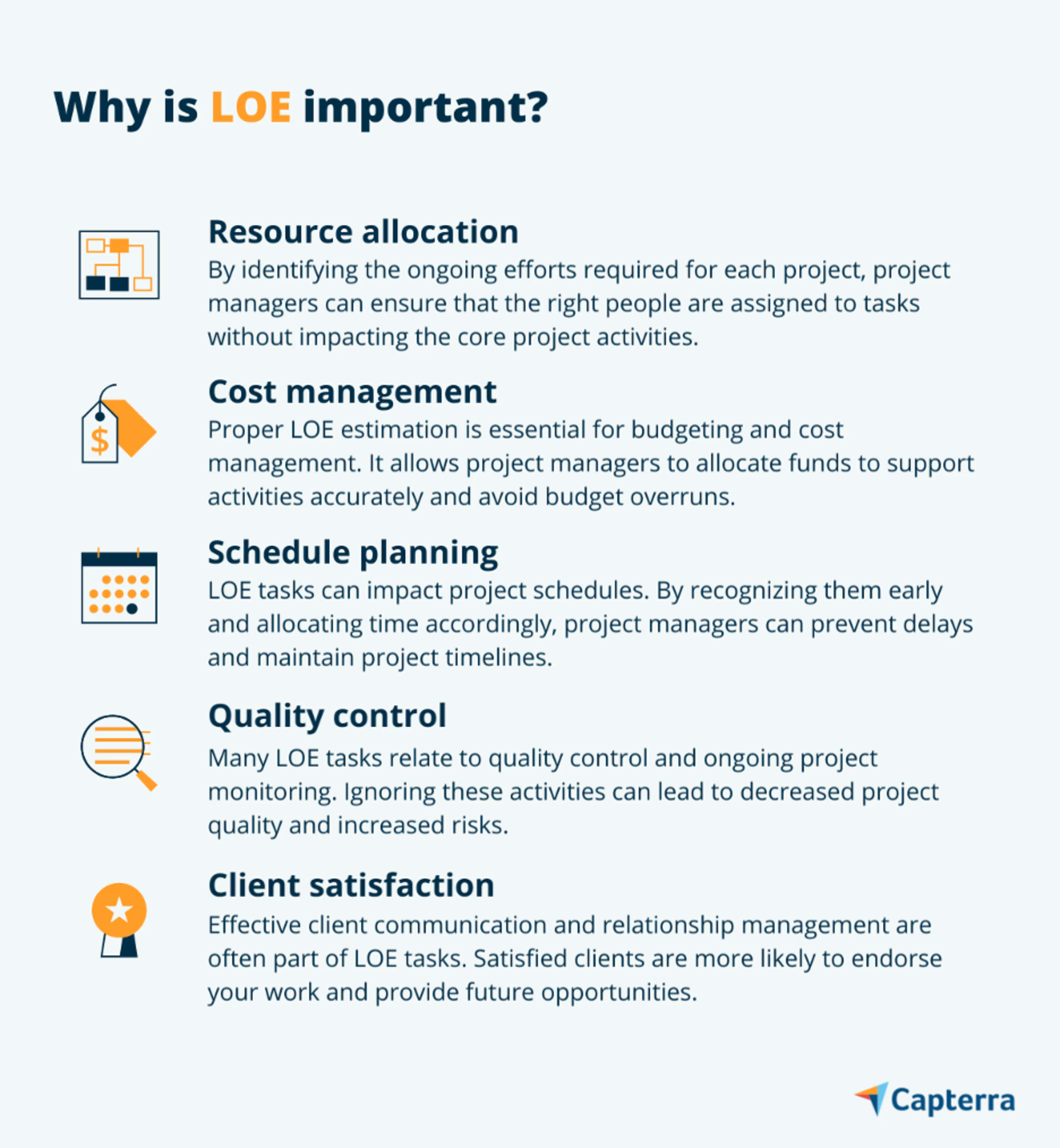Can measuring LOE make your projects run more smoothly?
Project management often involves estimating the effort required to complete tasks and deliverables. However, some activities, such as ongoing support and maintenance, are difficult to estimate in terms of duration or resource requirements. This is where the concept of Level of Effort (LOE) comes in handy.
LOE refers to work that has no clear completion criteria and is typically measured in labor hours rather than task duration. Without proper LOE estimation, project managers may underestimate the total amount of effort and resources required for tasks or particular projects. This can lead to unrealistic schedules, budget overruns, and resource constraints down the line.
Clearly defining and tracking LOE is crucial for keeping projects on track. This guide will explore common estimation challenges, how LOE addresses those, and best practices for incorporating LOE into project plans and processes. With a solid understanding of LOE, project managers can better account for all efforts and mitigate risks of cost and schedule overruns.
What is LOE in project management?
Level of Effort (LOE) refers to the total work effort required, not the time duration to complete it. It is estimated based on the work involved such as meetings, documentation, communication, and rework. It accounts for all types of effort that support project activities, milestones, and deliverables. Unlike fixed duration estimates, LOE focuses on the labor hours needed. The same LOE may take different amounts of time depending on assigned resources. Understanding these key aspects helps project managers accurately estimate and track LOE.
Let’s look at some common examples of activities that require LOE estimation and management:
Project management activities: Track the effort it takes for standard PM functions such as planning, budgeting, scheduling, risk management, status reporting, and change control.
Project budget accounting: Measure the work involved in tracking and controlling project costs, managing invoices, and performing regular budget reviews.
Customer and seller communications: Determine the LOE for meetings, calls, presentations, requirement reviews, and day-to-day discussions between client and delivery teams.
Equipment maintenance during manufacturing: Include the effort it takes for preventative upkeep and repair work in LOE to keep production machines running.
Team meetings: Estimate LOE for regular standups, retrospectives, reviews, and planning sessions.
Clerical responsibilities: Include administrative efforts such as setting up project tools, managing documentation, taking notes, and coordinating logistics in LOE.
Subject matter expert reviews: Account for LOE when key SMEs assess deliverables, provide input, and support testing.
Status reporting: Factor in effort to produce regular project status updates, dashboard refreshes, and management reports in LOE.
Travel time: Incorporate LOE for team members to commute for on-site meetings, workshops, and other project activities.
Why is LOE important?
Understanding the importance of LOE in project management is crucial for successful project execution. Here are a few key reasons why LOE matters:

What are the different types of LOE?
LOE can take various forms, depending on the nature of the project and the industry. Here are some common types:
Administrative LOE
This includes tasks related to project documentation, reporting, and communication. Administrative LOE is crucial for keeping stakeholders informed and maintaining project transparency.
Monitoring and control LOE
Tasks associated with project monitoring, quality control, and risk management fall under this category. Monitoring and control LOE ensures the project is on track and aligns with its objectives.
Support LOE
Support tasks are essential for providing the necessary infrastructure, tools, and resources to carry out the project successfully. These may include IT support, equipment maintenance, or facility management.
Management LOE
Tasks that involve project planning, coordination, and team management are considered management LOE. Effective management is fundamental to project success.
Estimating LOE
Estimating LOE accurately is crucial for project planning and resource allocation. Here are some tips to help you estimate LOE effectively:
Identify LOE tasks: Start by identifying tasks that don’t produce specific deliverables but are essential for the project’s success. Consult with team members and stakeholders to ensure you capture all relevant activities.
Quantify effort: Assign effort units to each LOE task. This could be in terms of hours, days, or any other unit that fits your project’s needs.
Historical data: Use historical project data to estimate LOE accurately. Past projects can provide valuable insights into the effort required for similar activities.
Expert input: Seek input from experienced team members who have a good understanding of LOE tasks. Their expertise can aid in precise estimation.
Review and adjust: Regularly review and adjust LOE estimates as the project progresses. This ensures that resources and schedules remain aligned with the project’s evolving needs.
What are best practices for LOE estimation and management?
To excel in LOE estimation and management, consider these best practices:
Start early
Initiate LOE estimation during the project planning phase to enable better resource allocation and scheduling.
Involve stakeholders
Consult with stakeholders and team members to ensure all LOE activities are identified and accurately estimated.
Use tools
Leverage project management software and tools to streamline LOE estimation and management processes.
Review and learn
After project completion, review LOE estimates against actual results, and use this feedback to improve future estimations and management.
Training and education
Invest in training and educating team members about LOE concepts and techniques to ensure more accurate estimations.
What are the common challenges associated with LOE?
Understanding the significance of LOE, or “Level of Effort,” is paramount in project management. However, this understanding wouldn’t be complete without acknowledging the common challenges that come with LOE estimation and management. These challenges include:
Subjectivity: Estimating LOE can be subjective and dependent on individual perspectives, making it challenging to achieve precision.
Changing requirements: Evolving project requirements may lead to changes in LOE tasks, requiring adaptability.
Resource constraints: Limited resources may affect the allocation of LOE tasks, potentially causing delays or inefficiencies.
Accountability: Ensuring accountability for LOE tasks can be challenging, as these responsibilities are often distributed among team members.
Balancing LOE and project work: Balancing LOE tasks with core project activities requires careful planning to prevent overloading team members.
Take your next steps toward measuring your LOE
LOE is a crucial project management concept that underpins planning, resourcing, budgeting, scheduling, monitoring, and control. Applying LOE best practices goes a long way toward enabling project success. With accurate LOE estimation, disciplined tracking, and proactive management, project teams can deliver within constraints and meet stakeholder expectations.
Learn more about project management with these resources:

